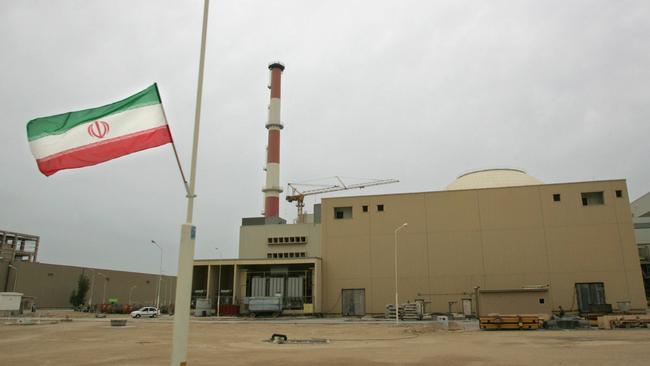UN confirms Iran produced uranium close to weapons grade
The International Atomic Energy Agency says discussions with Tehran are under way to ‘clarify the matter’.

The UN atomic agency confirmed on Tuesday that its inspectors had found traces of near weapons-grade nuclear material at Iran’s underground Fordow facility, but said Iran was still enriching to the less dangerous level of 60 per cent at the site.
Iran has been producing 60 per cent enriched uranium for almost two years. But the International Atomic Energy Agency said it had found traces of near weapons-grade 84 per cent during an January 22 inspection, according to a confidential report sent to member states and viewed by The Wall Street Journal.
The 60 per cent material, which no other non-nuclear weapons state is producing, can be quickly turned into weapons-grade material, which is considered to be around 90 per cent enriched.
The IAEA said Iran claimed in a letter that what the agency found at Fordow was the result of “unintended fluctuations in enrichment levels”. The report said that “discussions between the Agency and Iran to clarify the matter are ongoing”.
Iran has been producing highly enriched material of 60 per cent purity since early 2021, higher than any other non-nuclear weapons state, according to the IAEA.
If Iran deliberately starts producing weapons-grade material, it could lead to crisis over the country’s nuclear activities. European diplomats have said that would be the trigger for them to move to formally kill a 2015 nuclear agreement, which lifted most international sanctions on Tehran in exchange for strict but temporary limits on Iran’s nuclear work. Western officials also say it could prod Israel to pursue a military attack on Iran’s nuclear program. Israeli officials haven’t been public about their plans.
Iran has greatly expanded its nuclear work since 2019, a year after the Trump administration took the US out of the 2015 nuclear accord. President Joe Biden’s efforts to revive the pact so far have failed.
Under the 2015 agreement, Iran was only supposed to enrich uranium up to 3.67 per cent for 15 years.
The particles of near weapons-grade material were found the day after inspectors discovered that Iran had connected cascades of centrifuges, machines which enrich uranium, without reporting this to the agency. The IAEA reported this undeclared work as a breach of Iran’s commitment to its member states on February 1.
Diplomats involved in the oversight of Iran’s nuclear activities say Tehran might also have experimented with pathways to producing weapons-grade material at the same time as they changed the configuration of the cascades.
A person close to the IAEA said it wasn’t clear if Iran’s production of near weapons-grade material was an accident or deliberate but noted the increase in the level of enrichment was a big jump. The person said the amount of 84 per cent material produced was likely very small.
The IAEA didn’t issue a separate report on the production of near weapons-grade material, saying it first needed to discuss the issue with Iran. That has raised concerns among some member states who are eager to ensure any Iranian decision to accumulate weapons-grade material would be immediately known.
The agency said in the report that it had in recent weeks increased the frequency of its visits to Fordow.
When the 84 per cent enrichment was earlier reported last weekend by Bloomberg, senior diplomats from the European countries said that, if confirmed, it would be an “unprecedented and extremely grave development”. The IAEA board of governors is scheduled to meet next week, with Iran possibly facing censure from and the US and the European countries over its nuclear activities. Tehran has in the past stepped up its nuclear work in response to being rebuked by the agency board. Iranian officials and two senior diplomats in Vienna have said IAEA director-general Rafael Grossi might visit Tehran in coming days to hold talks with Iranian officials. The IAEA hasn’t responded to questions on whether the visit will happen.
In its report, the IAEA said Iran’s stockpile of 60 per cen highly enriched uranium had increased by over a third in the last three months, by far the biggest jump. That is because since November, the material has been produced at Fordow as well as Iran’s Natanz nuclear facility.
It now has 87.5kg of 60 per cent enriched uranium, up 25.2kg. That is far above the amount of highly enriched uranium it would need for a nuclear weapon.
The agency also flagged a new concern in its report, saying Tehran had acknowledged a discrepancy in the amount of natural uranium had reported it dissolved at Iran’s Uranium Conversion Facility in Isfahan.
The IAEA’s core mandate is to ensure no nuclear material is diverted from peaceful use.
Two senior diplomats overseeing Iran’s activities said the discrepancy was connected to Iran’s dissolution of a natural uranium metal disc the IAEA has been looking for as part of a probe into undeclared nuclear material found in Iran.
The IAEA had long known about the presence of a uranium metal disc in Iran, which western officials think was connected to Iran’s past nuclear weapons work. Tehran has always said its nuclear work was purely for peaceful purposes.
The Wall Street Journal



To join the conversation, please log in. Don't have an account? Register
Join the conversation, you are commenting as Logout